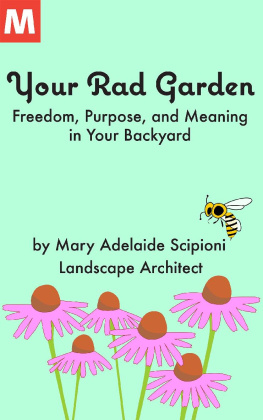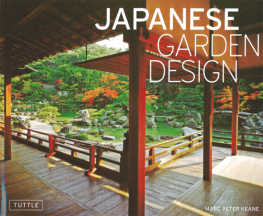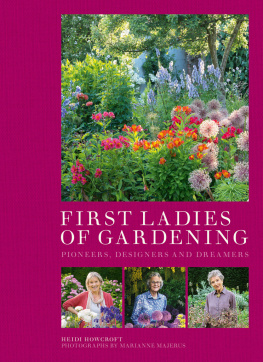
The
History of
Landscape
Design in
100 Gardens
Linda A. Chisholm
with Photography by Michael D. Garber
Timber Press Portland, Oregon
For Alan

Roberto Burle Marx design at Copacabana Beach.
Contents


The Bog Garden, Shute.
Preface

Many years ago l left my Dust Bowl Oklahoma home to go to college in New Yorks lush and bountiful Hudson Valley. There I would take courses that in one way or another taught me that central to human experience is our relationship to our natural surroundings and that we have, from time immemorial, shaped the landscape to our ideal. As I studied the importance of rivers, I thought about the contrast between the all-but-dry Arkansas in my home city and the deep and wide Hudson on which as college students we skated in winter.
In literature, I studied Aeneass harrowing voyage in the Mediterranean from Troy to what would become Rome, including the tricky passage between the rocky shoals of Scylla and the whirlpool of Charybdis. I considered the struggle between Captain Ahab and the great white whale Moby Dick. Courses in religion were replete with references to sea and land and to mans attempt to control through farming, fishing, and shepherding.
Then I read the great American novel The Grapes of Wrath, about the tragedy of my home state. There, in the nineteenth and early twentieth centuries, farmers had in ignorance cut down the forests and tall grasses that once covered the state holding the fertile topsoil in place. With the felling of the trees and poor farming practices, strong winds carried away layer upon layer of rich soil, eventually leaving the land barren. Franklin Roosevelts Civilian Conservation Corps had planted millions of tree seedlings, but these were but saplings when I was growing up in the 1940s and 1950s. Thousands, like the Joad family in the novel, abandoned the useless farmland and migrated in their Ford pickup trucks to California where they hoped to prosper. Like the Joads, most did not. As I read this tale of man and nature, I recalled the hollow look of impoverished farmers and their ragged children that were part of my childhood.
In history courses, the theme of humankinds relationship to nature came up again and again as we studied the impact, good and bad, that we have had on the places we have settled and how we have used and re-formed the earth for our purposes.
It was Professor Joan Kennedy (later Joan Kennedy Kinnaird) who first mentioned to me the landscape designer with the unforgettable name of Capability Brown. She talked about the dramatic change in landscape design in the eighteenth century and, almost as an aside, mentioned that landscape design reflects a culture, that by studying the prevailing styles of landscape and garden design we can learn what a culture thinks and values. Of chief importance is the way people in a particular time and place experience and understand nature. I thought about how in the Oklahoma of my childhood we expressed our relationship with nature as eking a living out of the soil and wrestling nature to the ground. To describe the soil we used the adjective stubborn so often that as a young child I thought the phrase one word. I knew that Henrik Hudson, discovering the river valley where I was studying and that would bear his name, would not have used these words. He would have exclaimed with wonder at its endless bounty and unspeakable beautyvirgin forests harboring deer and bears, the river and streams that fed it home to fish, ducks, beavers, muskrats, otters, and turtles, and the air above rich in variety and quantity of birds.
Lancelot Brown, 17161783, known to all as Capability Brown, was the most influential landscape designer in the history of the Western world. His landscape park design became associated with the growth of democracy, still dominates English country estates, and was exported to virtually every place the English set their flag where it is often simply called an English garden.
The question of human relationships to natural surroundings followed me as I studied history in graduate school and was extended to ask what ideas, beliefs, and hopes are expressed in the designs we choose for celebrated or humble gardens. I read about the great gardens and, traveling internationally for my work, was privileged to visit many of them. My research has culminated in my teaching the history of landscape design at the New York Botanical Garden and, now, in writing this book.
In it I relate my findings through one hundred of the worlds great gardens, chosen to illustrate the history and principles of landscape design and to answer the question of why a particular style became dominant at a specific time and place in history. What is the message a garden or landscape conveys and what design features illuminate the message?
I make no claim that my choices are the worlds one hundred greatest gardens. Great gardens they are, but I selected them to illustrate important moments in the sometimes evolutionary, sometimes revolutionary history of garden and landscape design, focusing on developments from around the world that have been most influential in North America and the United Kingdom.
Some are public spaces. Many are owned and governed by a foundation including those of the National Trust in England. A number are World Heritage Sites. All of these are open to the public. In addition, photographer Michael D. Garber and I were graciously welcomed by the owners of the private estates that are not generally open.
I have written the book for those who love gardens and gardening, who love history, literature, and art, and who like to see connections. The role of horticulture and landscape design in shaping our history has been neglected until recently. I make claims about how, on occasion, plants, horticulture, and garden design changed the Western world, especially focusing on England and the United States. Fortunately, with renewed interest in healthy eating and agricultural practices, schools have added these topics to the lessons for children. We need to ensure that for adults these developments are not relegated to the sidelines for intense study by just a few because, just as landscape design was influenced by the culture of a particular time and place, so the designers and their art have influenced intellectual, political, and social history. Without such inclusion, our understanding of history is incomplete and inaccurate.
It is my hope that for those training for or practicing the profession of landscape architect or designer, knowledge of the history of landscape design will increase the array of options in their toolkit of design ideas. Landscape design, as do other arts forms, borrows freely from the past, sometimes replicating but as often adapting an old idea to suit a new purpose. To that end this books index includes concepts, principles, design techniques, and garden features. Teachers of landscape architecture and design as well as students will, I trust, find this useful. Todays designers are, with their art, addressing age-old questions. Understanding the past is essential to understanding the present and to shaping the future.
Next page











